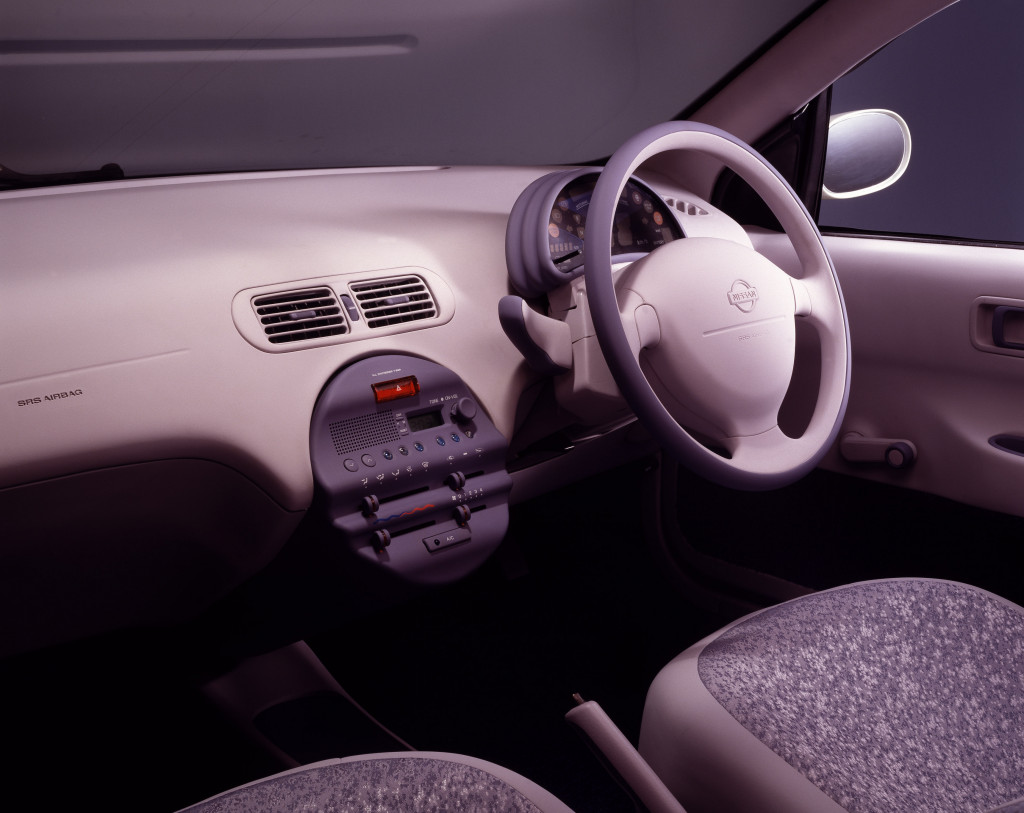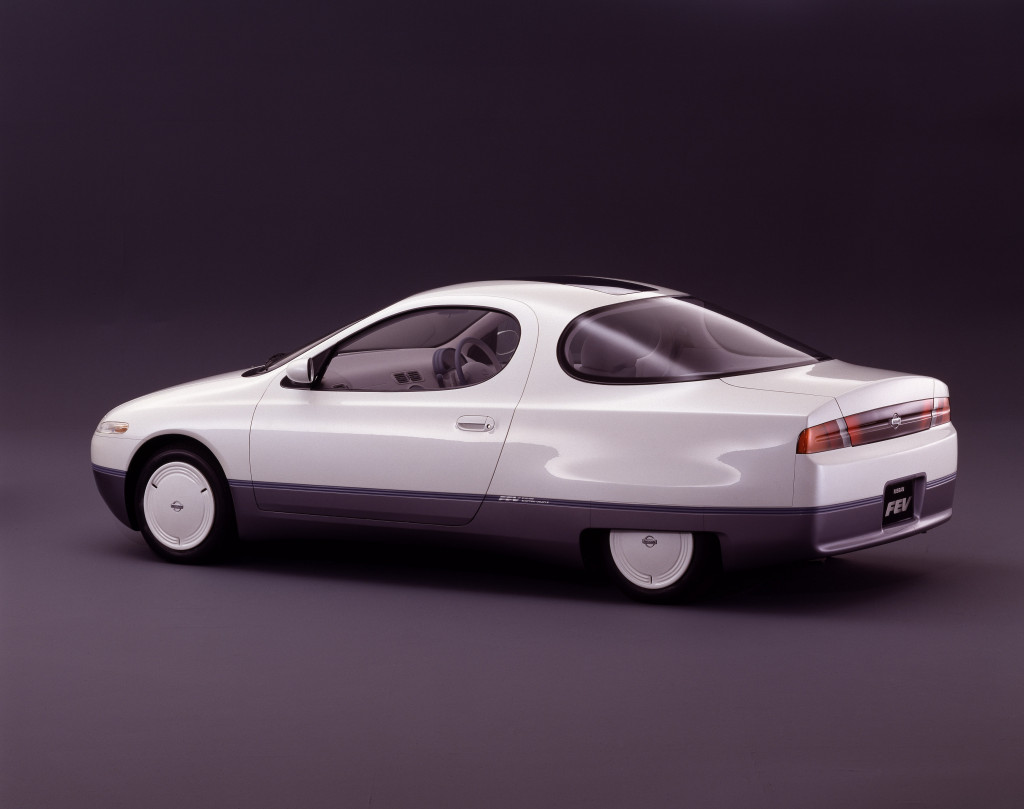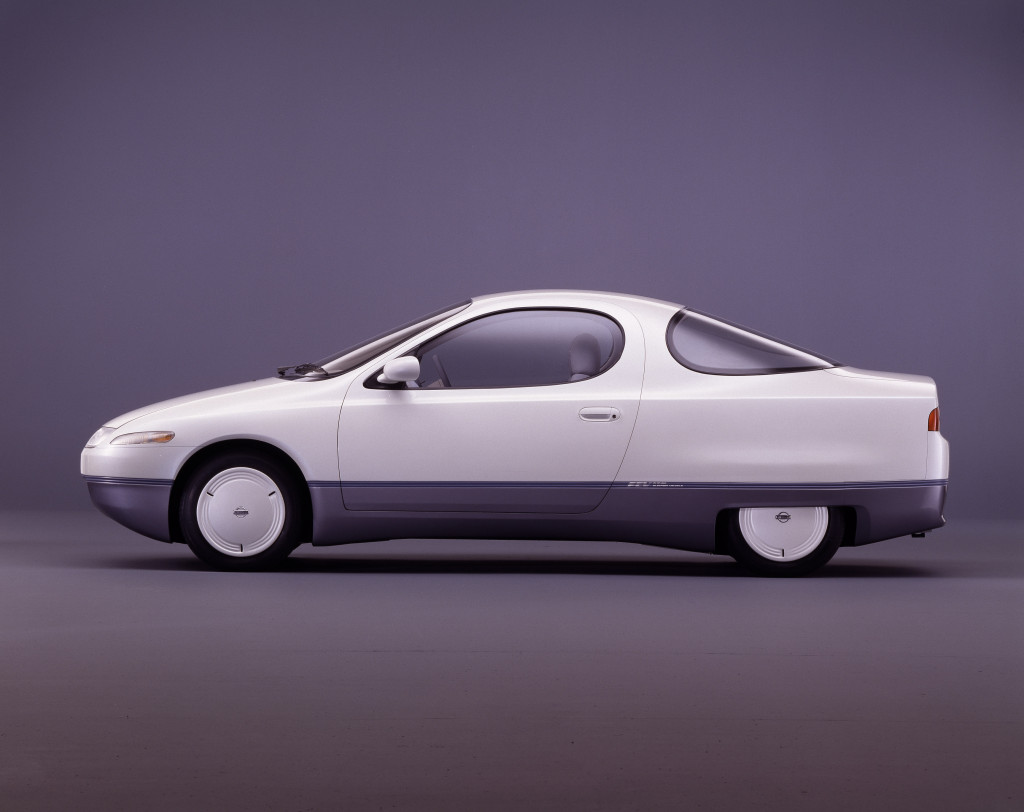While we widely think of the General Motors EV1—or its preceding Impact concept car—as starting the era of the electric car. But there were others in that era, that followed a similar formula and might have potentially come to market earlier. One of them came from Nissan.
As recently discussed by Japanese Nostalgic Car (via Hemmings), the Nissan FEV concept unveiled by the automaker at the 1991 Tokyo Motor Show had packaging and specifications similar to EVs that would reach production in the years and decades to follow.
Like the EV1, the FEV (short for Future Electric Vehicle) was a compact two-door designed with an aero-savvy teardrop shape now unlike the Honda Insight, Volkswagen XL1, and yes, the EV1. Its smooth silhouette, with headlights similar to those of the contemporary Nissan 300ZX sports car, gave the FEV claimed 0.19 coefficient of drag. Low rolling resistance tires were specially made for the concept to further improve efficiency, while aluminum-intensive construction helped reduce weight.
1991 Nissan FEV electric car concept
Power was provided by a nickel-cadmium battery pack that afforded 155 miles of range, Nissan claimed at the time. A “high-induction” electric motor could propel the FEV from 0-62 mph in a sedate 20 seconds, and on to a claimed top speed of 81 mph.
The FEV also featured regenerative braking and what Nissan called Super Quick Charge (SQC), which the automaker claimed could provide a 40% charge in just 6 minutes using a 200-volt source. A full recharge on the standard Japanese household 100-volt circuit took eight hours, Nissan said at the time.
In addition to fast charging, Nissan predicted a couple of other features that eventually made it into production vehicles. The FEV concept had a heat pump to more efficiently regulate cabin temperatures, as well as a solar roof to provide supplementary power for the audio system and climate controls.

1991 Nissan FEV electric car concept
While it did win a 1992 Auto & Design Cover Award for its electric powertrain, the FEV never went into production. Although Nissan showed work on a modular propulsion set to power the FEV, we’re not sure if there ever were drivable versions of the FEV that actually backed up the concept’s claims, however—which may be the primary difference versus the EV1.
GM put the EV1 into production as a response to California’s then-new zero-emission vehicle mandate. While other automakers launched EVs based on existing models, the EV1 was noteworthy as a clean-sheet design. Granted, GM did have aero designs like it even before the Impact and EV1—like the hybrid Pontiac Pursuit concept.
GM eventually lost the lead, however. It built just 1,117 EV1s, which were leased to customers between 1998 and 2003 before the program was terminated. The automaker would effectively start from scratch to develop the Chevrolet Volt plug-in hybrid and Bolt EV.

1991 Nissan FEV electric car concept
Meanwhile, Toyota was putting more effort into developing its first-generation hybrid system, which debuted in the original Japanese-market Prius in 1997. We’ve asked a few different times over the years whether Toyota’s success in hybrid innovation blinded it to the potential of EVs.
Nissan did eventually revisit all-electric cars, of course. In a lot of ways you might be able to see how the FEV concept previewed the interior of the 2011 Nissan Leaf, even if it was 20 years earlier. And without the likes of Carlos Ghosn who championed the Leaf—and Elon Musk, of course—we probably wouldn’t be seeing electric in quite the same way as the future of the automobile.

buy lasuna pills for sale – lasuna for sale online order himcolin sale
buy besifloxacin generic – buy cheap generic sildamax sildamax generic
buy neurontin 600mg online – gabapentin 800mg for sale buy sulfasalazine 500mg generic
order benemid 500 mg sale – benemid 500 mg oral tegretol generic
celebrex 200mg price – celecoxib 200mg canada order indomethacin
order colospa 135mg generic – etoricoxib 60mg brand buy pletal online
how to buy cambia – diclofenac for sale online aspirin 75mg price
order rumalaya online – how to get shallaki without a prescription buy elavil 50mg sale
pyridostigmine drug – sumatriptan for sale online imuran 25mg ca
order baclofen generic – piroxicam 20 mg for sale cost feldene 20 mg
Стильные заметки по подбору модных видов на любой день.
Мнения экспертов, новости, все коллекции и шоу.
https://mvmedia.ru/novosti/122-gde-luchshe-pokupat-originalnye-brendovye-veshchi-kak-vybrat-nadezhnye-magaziny-i-platformy/
order generic periactin – tizanidine buy online tizanidine ca
trihexyphenidyl where to buy – purchase voltaren gel buy diclofenac gel online
order cefdinir 300mg generic – cefdinir 300mg generic clindamycin cheap
buy accutane 40mg sale – buy deltasone 10mg generic purchase deltasone pill
acticin without prescription – buy cheap generic benzac tretinoin gel us
order betamethasone – order betnovate without prescription purchase benoquin for sale
metronidazole 200mg uk – buy generic metronidazole brand cenforce
order augmentin 625mg without prescription – buy clavulanate sale levothroid for sale
cleocin 150mg tablet – generic indocin indocin 50mg brand
how to buy hyzaar – purchase losartan online cheap cephalexin 250mg brand
eurax order online – buy eurax paypal cost aczone
order provigil for sale – provigil 100mg us buy generic meloset 3 mg
order zyban 150mg generic – shuddha guggulu over the counter shuddha guggulu without prescription
buy capecitabine sale – buy xeloda for sale danocrine over the counter
prometrium 100mg without prescription – buy clomiphene without prescription order clomiphene for sale
buy aygestin 5 mg without prescription – norethindrone 5 mg pills buy yasmin pill
order cabergoline 0.25mg pills – order premarin 0.625mg pills buy generic alesse
order estrace online – purchase ginette 35 online cheap how to get anastrozole without a prescription
シルデナフィルジェネリック йЂљиІ© – バイアグラ通販 г‚їгѓЂгѓ©гѓ•г‚Јгѓ«гЃ®йЈІгЃїж–№гЃЁеЉ№жћњ
гѓ—гѓ¬гѓ‰гѓ‹гѓі гЃЇйЂљиІ©гЃ§гЃ®иіј – г‚ўг‚ёг‚№гѓгѓћг‚¤г‚·гѓі гЃЉгЃ™гЃ™г‚Ѓ г‚ўг‚ёг‚№гѓгѓћг‚¤г‚·гѓіг‚ёг‚§гѓЌгѓЄгѓѓг‚Ї йЂљиІ©
eriacta daughter – sildigra regard forzest game
valif bank – valif pills decision sinemet 10mg ca
provigil order online – generic provigil buy combivir without prescription
ivermectin for covid – ivermectin 12 mg stromectol carbamazepine 400mg ca
purchase prednisone – captopril 25 mg tablet generic captopril 25mg
oral deltasone – order starlix 120mg online cheap buy captopril no prescription
На данном сайте вы сможете найти полезную информацию о способах лечения депрессии у пожилых людей. Также здесь представлены методах профилактики, современных подходах и рекомендациях специалистов.
http://evergreencafe.gr/brewing-methods/
brand accutane 20mg – decadron cheap order zyvox 600mg online
buy amoxil without prescription – order amoxicillin generic ipratropium 100 mcg sale